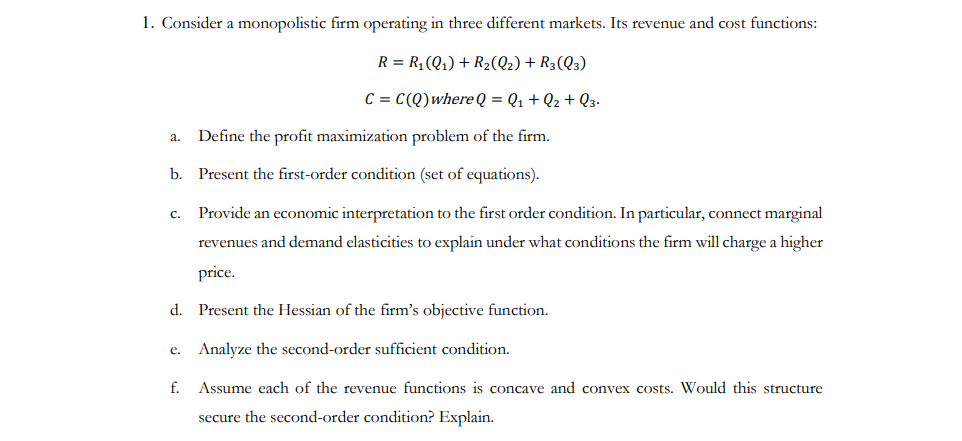1. Consider a monopolistic firm operating in three different markets. Its revenue and cost functions: R = R₁ (Q₁) + R₂(Q2) + R3(Q3) C = C(Q) where Q = Q₁ + Q₂ + Q3- a. Define the profit maximization problem of the firm. b. Present the first-order condition (set of equations). c. Provide an economic interpretation to the first order condition. In particular, connect marginal revenues and demand elasticities to explain under what conditions the firm will charge a higher price. d. Present the Hessian of the firm's objective function. e. Analyze the second-order sufficient condition. f. Assume each of the revenue functions is concave and convex costs. Would this structure secure the second-order condition? Explain.
1. Consider a monopolistic firm operating in three different markets. Its revenue and cost functions: R = R₁ (Q₁) + R₂(Q2) + R3(Q3) C = C(Q) where Q = Q₁ + Q₂ + Q3- a. Define the profit maximization problem of the firm. b. Present the first-order condition (set of equations). c. Provide an economic interpretation to the first order condition. In particular, connect marginal revenues and demand elasticities to explain under what conditions the firm will charge a higher price. d. Present the Hessian of the firm's objective function. e. Analyze the second-order sufficient condition. f. Assume each of the revenue functions is concave and convex costs. Would this structure secure the second-order condition? Explain.
Principles of Economics, 7th Edition (MindTap Course List)
7th Edition
ISBN:9781285165875
Author:N. Gregory Mankiw
Publisher:N. Gregory Mankiw
Chapter16: Monopolistic Competition
Section: Chapter Questions
Problem 4PA
Related questions
Question
Please help solve this and explain into details. Thank you so much.

Transcribed Image Text:1. Consider a monopolistic firm operating in three different markets. Its revenue and cost functions:
R = R₁ (Q₁) + R₂(Q2) + R3(Q3)
C = C(Q) where Q = Q₁ + Q₂ + Q3.
a.
b.
C.
e.
Define the profit maximization problem of the firm.
Present the first-order condition (set of equations).
d. Present the Hessian of the firm's objective function.
Analyze the second-order sufficient condition.
Assume each of the revenue functions is concave and convex costs. Would this structure
secure the second-order condition? Explain.
f.
Provide an economic interpretation to the first order condition. In particular, connect marginal
revenues and demand elasticities to explain under what conditions the firm will charge a higher
price.
Expert Solution
This question has been solved!
Explore an expertly crafted, step-by-step solution for a thorough understanding of key concepts.
This is a popular solution!
Trending now
This is a popular solution!
Step by step
Solved in 4 steps

Follow-up Questions
Read through expert solutions to related follow-up questions below.
Follow-up Question
Continue from part d to part f. Thank you!

Transcribed Image Text:1. Consider a monopolistic firm operating in three different markets. Its revenue and cost functions:
R = R₁ (Q₁) + R₂(Q2) + R3(Q3)
C = C(Q) where Q = Q₁ + Q₂ + Q3.
a.
b.
C.
e.
Define the profit maximization problem of the firm.
Present the first-order condition (set of equations).
d. Present the Hessian of the firm's objective function.
Analyze the second-order sufficient condition.
Assume each of the revenue functions is concave and convex costs. Would this structure
secure the second-order condition? Explain.
f.
Provide an economic interpretation to the first order condition. In particular, connect marginal
revenues and demand elasticities to explain under what conditions the firm will charge a higher
price.
Solution
Knowledge Booster
Learn more about
Need a deep-dive on the concept behind this application? Look no further. Learn more about this topic, economics and related others by exploring similar questions and additional content below.Recommended textbooks for you

Principles of Economics, 7th Edition (MindTap Cou…
Economics
ISBN:
9781285165875
Author:
N. Gregory Mankiw
Publisher:
Cengage Learning

Principles of Economics (MindTap Course List)
Economics
ISBN:
9781305585126
Author:
N. Gregory Mankiw
Publisher:
Cengage Learning

Principles of Microeconomics (MindTap Course List)
Economics
ISBN:
9781305971493
Author:
N. Gregory Mankiw
Publisher:
Cengage Learning

Principles of Economics, 7th Edition (MindTap Cou…
Economics
ISBN:
9781285165875
Author:
N. Gregory Mankiw
Publisher:
Cengage Learning

Principles of Economics (MindTap Course List)
Economics
ISBN:
9781305585126
Author:
N. Gregory Mankiw
Publisher:
Cengage Learning

Principles of Microeconomics (MindTap Course List)
Economics
ISBN:
9781305971493
Author:
N. Gregory Mankiw
Publisher:
Cengage Learning


